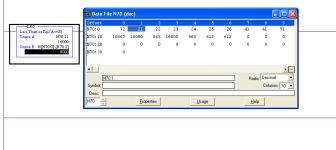n.costasilva
Member
Hello experts,
I am just starting with AB programing, I have a questions regarding a compare done in an old RSlogix500 and causing me issues when I try convert to RSlogix5000.
I'm facing difficulties to understand what was the idea in this compare logic.
I would appreciate if you could give me some tips.
My main question is to understand from where the 8000 in source B is coming from, the source B seems to be a calculation between N70.0 and N70.2, but I cant figure it out yet.
Thank you in advance.

I am just starting with AB programing, I have a questions regarding a compare done in an old RSlogix500 and causing me issues when I try convert to RSlogix5000.
I'm facing difficulties to understand what was the idea in this compare logic.
I would appreciate if you could give me some tips.
My main question is to understand from where the 8000 in source B is coming from, the source B seems to be a calculation between N70.0 and N70.2, but I cant figure it out yet.
Thank you in advance.





